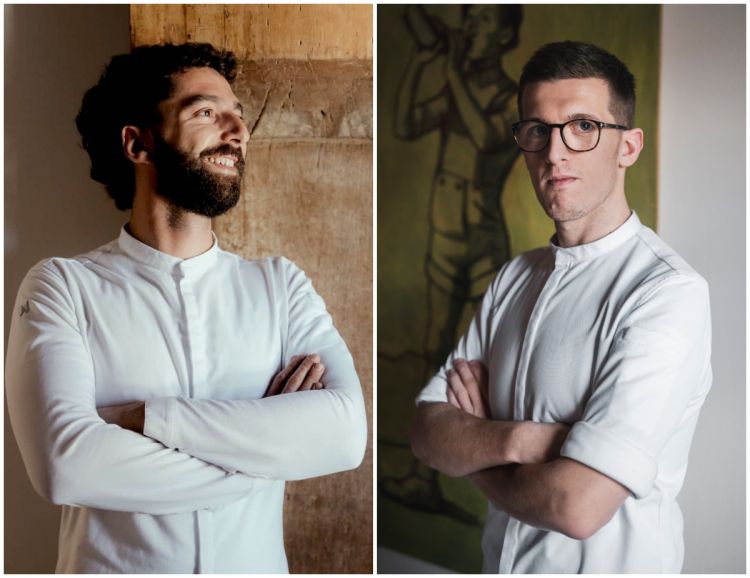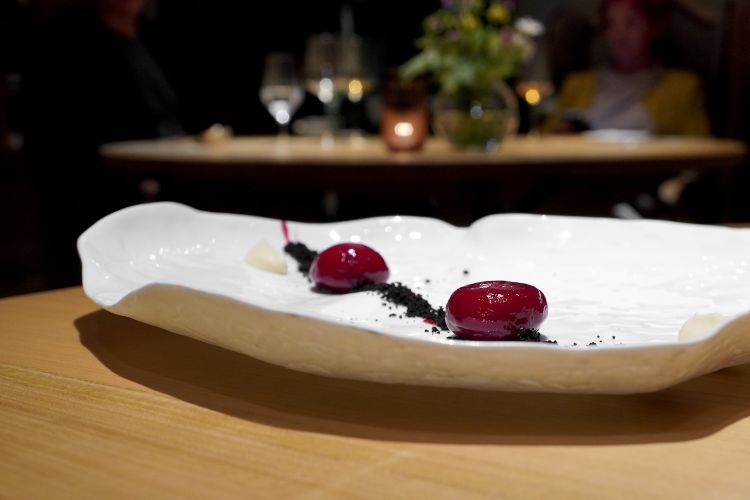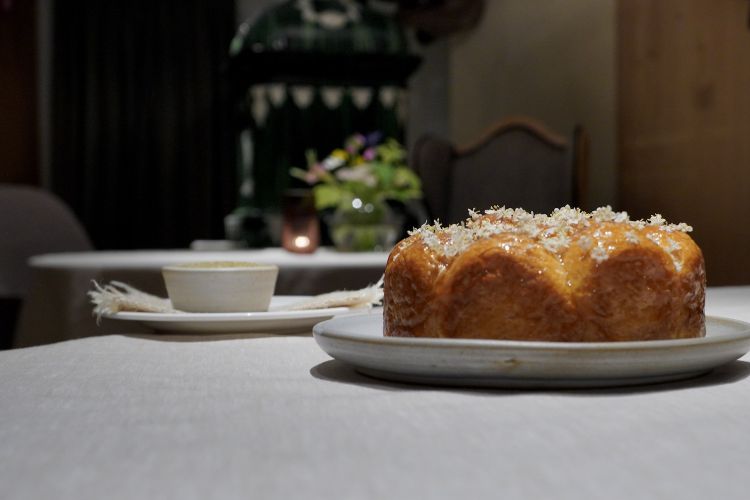The mountain man proceeds with a slow and assertive pace. He knows that to reach the top you need time, determination, knowledge of the surroundings. In fact you almost need to be in a symbiosis with nature. It’s not recommended to run to move on with your project. You need perseverance.
It took Norbert Niederkofler a lot of time to elaborate his project, called Cook the mountain. Now that it is defined and celebrated, he pursues it with perseverance. And he respects its principles and timings. He is its keeper, creator and thinker. Over time he’s taken one step back in the kitchen: today his role is most of all that of spreading his values: he’s almost a culinary ideologist. As he explains:
To find the answers, I started from my roots and then listened to current trends that rediscover the local territory, the respect for biodiversity, the spreading of local and organic products, the slow living mentality that follows the season. And so the goal became immediately clear: to rethink economic-social development investigating the relationship between production, product, territory and consumption. The starting point in this change must be the kitchen, by which I mean a “catalyser of cultural processes” for the spreading of a sustainable model. In this sense, the cook must take the role of “emotional educator”, capable of promoting a new lifestyle.
On our last visit to St. Hubertus, a few weeks ago, the menu was surprisingly similar to the one tasted time ago. Static? Repetitive? Quite the contrary: a phase of passage in the full development of the project.
Cook the mountain grows slowly with the spreading of its message. It’s a development that passes also through some goodbyes, like the recent one of Michele Lazzarini, which Norbert had trained and to whom for a few years now he had basically handed the kitchen: today he’s the protagonist of a new challenge, in Lombardy, at Contrada Bricconi, we wrote about it here.
It's a loss for St. Hubertus but a move forward for the mountain, so to speak. Niederkofler is a safeguard and point of reference but the spreading must continue by itself, arriving everywhere, and not just in the mountains. It must involve mostly the new generations of cooks, hence it must lose its personalisation (the step back taken by Norbert) to look at the future, so that it’s not – and we can say for sure it will not be – just the personal thought of a cook, no matter how excellent, but a sort of stable school of thought, rooted in the territories. So it’s no coincidence that the next Care's will have as its protagonists the pupils (of Niederkofler? No, of Cook the mountain): Lazzarini of course, but also Andrea Tortora, and then maybe even Giacomo Sacchetto, Nicola Laera, Matteo Metullio, Nino Rossi, Diego Rossi, just to name a few... They have all been born from this litter in a way.

Jacopo Lucini Paioni and Mauro Siega
But we were saying: a surprisingly similar menu (not the same! There is an evolution, there are some novelties. Yet it is similar) to the one we tasted some time ago: because that was a tasting menu designed (and handed to)
Lazzerini, alter ego of
Norbert, who had great creative freedom within the borders traced by the big chief. Today there are two new "helpers in the field", promoted from within the brigade:
Jacopo Lucini Paioni, born in 1991 in Castelleone (Cremona), previously at
Daní Maison wit
Nino Di Costanzo, at
Metropole in Venice and at
Combal.Zero; here he’s now kitchen manager. And then there’s
Mauro Siega, born in 1992 in Maniago (Pordenone), with previous experience around half the world, France, Australia, England, Germany: he is the new creativity manager.
It's up to them. We’ll have plenty of surprises.

Lukas Gerges and Norbert Niederkofler
While in the kitchen there is a sort of transition, a certainty is given instead by the dining room and cellar:
Lukas Gerges is a star, he’s worth the trip alone. He pulls out of the hat a series of surprises: for his pairings are the most interesting of all, at this standard, in Italy.
And now our dinner, as portrayed by Tanio Liotta.

Tartlet of buckwheat, braised onion, pasteurised pork blood Delizia di Monte (it’s BergGenuss, a cow’s milk cheese matured for a year by Hubert Stockner in a natural cave and WWI bunker in San Lorenzo di Sebato, Bolzano, which became a storage house for delicious cheese made with raw milk, at 99% humidity, genussbunker.it)

This marinated char (in salt, sugar and dill) and smoked (in the caves where they age speck, hence the aroma of juniper), is paired with thyme and lemon flowers to be dipped in a fantastic cream reduced till it’s caramelised and served with some grated horseradish

Bruschetta of rye bread with sauce of "mountain tomato" (that is to say a reduction of fermented plums

Insalata dell'orto. This salad from the vegetable garden is made of 25-30 herbs and flowers, with three types of lettuce that come from a vegetable garden in Kronplatz. Then there are rye chips with flax, pumpkin seeds and clover, amaranth seeds, dehydrated Jerusalem artichoke and it’s all soaked with kombucha with elderberry flowers. As intense as it gets. The pairing is with Total Green, a juice of green apple and herbs

Exceptional balance and perfect taste in this Tartare of whitefish. The filet is in the middle, the scales are boiled and then fried to add a crispy note. The bones are toasted and then infused to make a sauce enriched with Terlano wine and lovage oil. Then elderberry capers. The dish is both intense and delicate, with beautiful vegetal notes and a total harmony

Another marvel: Glazed eel & smoked broth. The glaze is with honey, hay and soy saba, then lard and sage leaves, all on the embers. On the side there’s a broth made with the toasted scraps of the eel, with melissa, mint, verbena and nasturtium

Beetroot gnocchi, a historical dish from 2013: made with beetroot and fresh horseradish, cream of daikon. On the bottom there’s soil made with puccia (the classic bread from South Tyrol made with rye and wheat and seeds of fennel and cumin, aromatised with beer and chargrill). A great dish

Spelt ditalini Monograno Felicetti in a cream of game, frozen crespino, root of imperatore (Peucedanum ostruthium)

Ditalini, a masterpiece of goodness

Veal sweetbreads & larch pinecones. The sweetbreads of the heart of veal are cooked with butter in a cast iron pan, on the embers. On the bottom there’s an emulsion of sour herbs, paired with the water of fermentation of the larch pinecones. Very good

Trout & juniper: chargrilled trout, water of tomato and fermented golden plums, juniper oil

Carota bbq. The carrot is cooked slowly on the embers and then on the grill, glazed with a bbbq sauce made with cherries, burnt apples, oil with burnt egg yolk and onion. Umami

Vitello dei nostri masi The veal loin is cooked at low temperature on the embers and paired with sour herbs and a mountain herb salad (dandelion, baby lettuce, baby spinach, home-made balsamic vinegar)

Mushroom, or mountain cappuccino. Different varieties of mushrooms that must be picked and dried. With them they make a broth and a mushroom air
![Yogurt gelato, water of black currants, thyme oil, lemon, caramelised acacia flowers, stalks of buon enrico [wild spinach]](https://www.identitagolose.it/public/images/xmedium/norbert-niederkofler-sthubertus-identita-golose-foto-tanio-liotta22.jpg)
Yogurt gelato, water of black currants, thyme oil, lemon, caramelised acacia flowers, stalks of buon enrico [wild spinach]

Strawberries, blackberries, cherries, frozen gooseberries, elderberry, thyme, lemon and black currants

Buchteln, the typical sweet pancakes, here glazed with an elderberry flower syrup, added to an emulsion of beeswax and hay